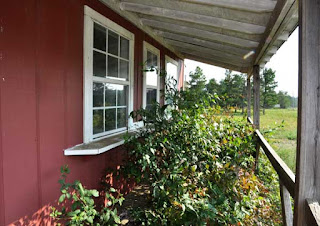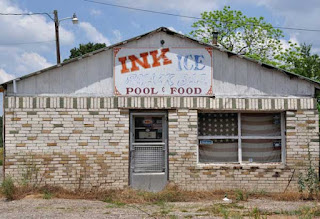 |
| Sign leading to Booger Hollow Trading Post |
A hollow (holler) is a narrow valley between hills and mountains. The word "Booger" is derived from the ancient Welsh word "Bwg," which meant "to scare." Eventually the word evolved into "Boo," Bogus," and "Booger," all of which have slightly different meanings, but all indicate something frightening or unknown.
In the 1800's, the road from Russellville to Dover ran through the Bull Frog Valley to the geographic site of where Booger Hollow is today. On either side of the hollow are two cemeteries. Locals believed the area was haunted by the inhabitants of the cemeteries. Few people went traipsing around by themselves after dark. The name Booger Hollow stuck and that's how it's known to this day.
The Booger Hollow Trading Post is situated on a mountain top about 10 miles from the actual Booger Hollow. At least the buildings are anyway. I recently took a little day trip to see this place with my own eyes and found that sadly, after 44 years in business, the doors were shut and it is no more. In early 2004, several people offered to buy the property from Charlotte Johnson, the owner. All indicated they wanted to keep the place open. After years of hard work with little time off, she wanted to slow down, to spend time with her family, so she sold to a couple from Green Forest. Unfortunately, they didn't make the payments and the place closed down. Charlotte got the place back, but the land beneath the buildings somehow legally went to someone else and although there were several attempts to re-open, the doors have remained closed since late that year.
 |
| Front porch of the post store. |
There used to be red and white signs, starting about 10 miles away in both directions, that advertised the cured hams, the ice cold drinks, the keepsakes, and said, "Booger Hollow, 9 miles;" "Booger Hollow, 8 miles" and so on. They drew you on, closer and closer, until you simply could not pass it up. They are gone now. There is still the population sign on the north side, but it is within feet of the turn in and I missed it before I could slow down enough. Fortunately, there is another turn in on the south side so I used that one to pull into the small gravel parking lot.
 |
| The empty store |
 Being careful to avoid the sticker bushes as much as possible, I peered through a broken pane at the rows of empty shelving inside the post. There was nothing left on the disarrayed shelves except dust and a few cobwebs. Making my way to the restaurant, I once again looked through broken windows and saw the old menu sign above the order-window, still advertising Boogerburger, $2.99, with cheese, $3.29. The kitchen area appeared neat and clean except for the layer of dust which covered everything. It looked like with a good cleaning, the Boogerburger could be cooked again tomorrow.
Being careful to avoid the sticker bushes as much as possible, I peered through a broken pane at the rows of empty shelving inside the post. There was nothing left on the disarrayed shelves except dust and a few cobwebs. Making my way to the restaurant, I once again looked through broken windows and saw the old menu sign above the order-window, still advertising Boogerburger, $2.99, with cheese, $3.29. The kitchen area appeared neat and clean except for the layer of dust which covered everything. It looked like with a good cleaning, the Boogerburger could be cooked again tomorrow.I stuck my camera through the broken glass and was focused on taking pictures when something big and black came hurtling through the air at my head! I instinctively jerked my head and hand back, lucky to not cut anything on the broken glass and for a split second, started to reach for the knife hanging at my side. I realized though, it was just a black bird, scared by me from the home he had probably made in the rafters, making his escape through the broken pane above the one I was looking through. I had to chuckle, picturing myself futilely flailing away like a madman with a knife in my hand at a bird flying around me. Alfred Hitchcock evidently is alive and well inside my head! Two cars sped past on the road and somehow, the uneasy feeling passed.
 |
| The cafe - and where a bird scared the daylights out of me! |
Perhaps someday, someone will come along, re-build and re-open the Booger Hollow Trading Post. Or perhaps it will continue to slowly wither away until it is just a distant memory in old people's thoughts and fading pictures. Personally, I would like to see it restored and opened again. It may have been a perpetrator of the hillbilly stereotype, but it's still sad to lose one of the great roadside attractions in America.
 |
| The infamous double-decker outhouse |
 |
| Note written beside the door to the cafe. "Ma" was obviously very loved by her grandchildren. |





























